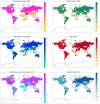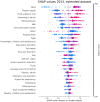Worldwide impact of lifestyle predictors of dementia prevalence: An eXplainable Artificial Intelligence analysis
- PMID: 36567754
- PMCID: PMC9772995
- DOI: 10.3389/fdata.2022.1027783
Worldwide impact of lifestyle predictors of dementia prevalence: An eXplainable Artificial Intelligence analysis
Abstract
Introduction: Dementia is an umbrella term indicating a group of diseases that affect the cognitive sphere. Dementia is not a mere individual health issue, since its interference with the ability to carry out daily activities entails a series of collateral problems, comprising exclusion of patients from civil rights and welfare, unpaid caregiving work, mostly performed by women, and an additional burden on the public healthcare systems. Thus, gender and wealth inequalities (both among individuals and among countries) tend to amplify the social impact of such a disease. Since at present there is no cure for dementia but only drug treatments to slow down its progress and mitigate the symptoms, it is essential to work on prevention and early diagnosis, identifying the risk factors that increase the probability of its onset. The complex and multifactorial etiology of dementia, resulting from an interplay between genetics and environmental factors, can benefit from a multidisciplinary approach that follows the "One Health" guidelines of the World Health Organization.
Methods: In this work, we apply methods of Artificial Intelligence and complex systems physics to investigate the possibility to predict dementia prevalence throughout world countries from a set of variables concerning individual health, food consumption, substance use and abuse, healthcare system efficiency. The analysis uses publicly available indicator values at a country level, referred to a time window of 26 years.
Results: Employing methods based on eXplainable Artificial Intelligence (XAI) and complex networks, we identify a group of lifestyle factors, mostly concerning nutrition, that contribute the most to dementia incidence prediction.
Discussion: The proposed approach provides a methodological basis to develop quantitative tools for action patterns against such a disease, which involves issues deeply related with sustainable, such as good health and resposible food consumption.
Keywords: AI for social good; One Health; complex systems; computational social science; data science for social good; dementia; eXplainable Artificial Intelligence; sustainable development goals.
Copyright © 2022 Bellantuono, Monaco, Amoroso, Lacalamita, Pantaleo, Tangaro and Bellotti.
Conflict of interest statement
The authors declare that the research was conducted in the absence of any commercial or financial relationships that could be construed as a potential conflict of interest.
Figures










References
-
- Adadi A., Berrada M. (2018). Peeking inside the black-box: a survey on explainable artificial intelligence (XAI). IEEE Access 6, 52138–52160. 10.1109/ACCESS.2018.2870052 - DOI
-
- Amoroso N., Bellantuono L., Monaco A., De Nicolò F., Somma E., Bellotti R. (2021a). Economic interplay forecasting business success. Complexity 2021, 8861267. 10.1155/2021/8861267 - DOI
LinkOut - more resources
Full Text Sources

